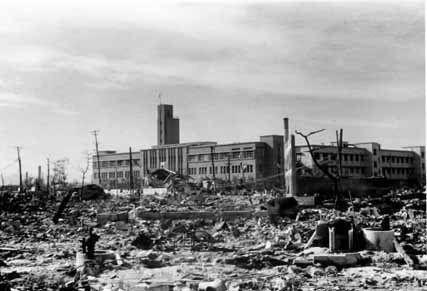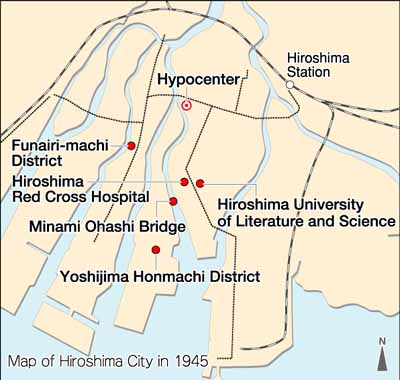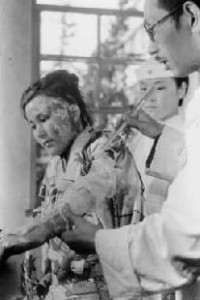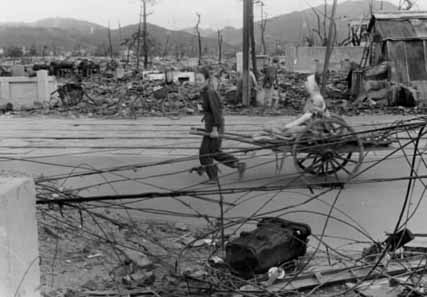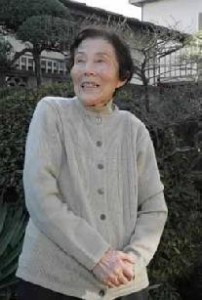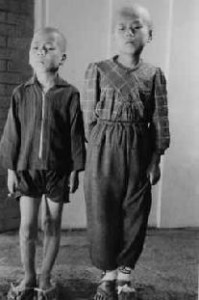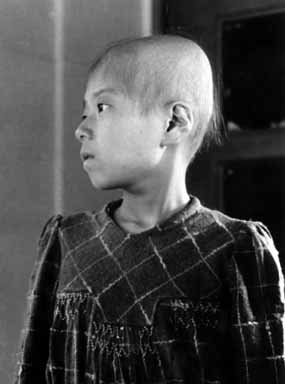- A-bomb Images
- The A-bomb Photographs of Shunkichi Kikuchi, Part Ⅱ: Images from Hiroshima Red Cross Hospital
The A-bomb Photographs of Shunkichi Kikuchi, Part Ⅱ: Images from Hiroshima Red Cross Hospital
by Masami Nishimoto, Senior Staff Writer
(Originally published on February 28, 2007)
Photographer Shunkichi Kikuchi took detailed photographs of Hiroshima right after the atomic bombing in 1945 and preserved a large number of negatives. In this article, the Chugoku Shimbun introduces his photographs taken at Hiroshima Red Cross Hospital, which gave devoted medical treatment to Hiroshima citizens and others at that time. Mr. Kikuchi wrote in his notes that he took the photos at the hospital between October 4 and 6, 1945. The Chugoku Shimbun interviewed the subjects in the photographs, who were identified from clues in his notes and documents. They reveal some of the effects of the atomic bombing.
“Mother” and child on a cart
“I thought to myself, ‘I wish I could die’,” recalled Toyoko Kugata, 84, a survivor of the atomic bombing now living in the city of Oyama in Tochigi Prefecture. As she studied her picture in one of Mr. Kikuchi’s photographs, she said quietly, “My face was terribly burned and the burns on my arm didn’t heal. I once shocked my mother by blurting out, ‘I would rather have my arm amputated than have these terrible burns!’ I was a woman in the prime of my life.”
At the time, Ms. Kugata worked for the Hiroshima Branch of Yasuda Life Insurance Company. She lived in nearby Yoshijima, an area with many rice paddies and farms. As she commuted to work, her route took her across the Minami Bridge and to a streetcar stop near the Hiroshima Red Cross Hospital. On August 6, 1945, she was walking on the Minami Bridge when she was blown by the explosion into the Motoyasu River. She had been standing only 1.7 kilometers south of the hypocenter. It was a miracle that she managed to survive.
“I tried to swim across the river,” she recalled, “but I couldn’t reach the bank on the other side. I wasn’t strong enough to swim, and I was clinging to a pillar underneath the bridge.” Countless dead bodies in terrible condition were strewn all along the riverbank and in the water. Ms. Kugata was saved by a military unit stationed nearby and taken to Ujina on their ship.
There she was laid on a straw mat and, for first aid, oil was applied to her burns. Later she was sent by boat from Kanawajima Island to Ninoshima Island in Hiroshima Bay, and then to Kuba Elementary School in the city of Otake, west of Hiroshima. In 1980, an “Institutionalized Patients List” from that time was discovered in Kuba. On the list was Ms. Kugata’s name. Her name had been circled, indicating that she was badly wounded. Of the 80 people whose names appeared on the list, 11 had died by August 14, the day before the end of the war.
“After my name was posted in Hiroshima, my mother and my cousin came to pick me up,” she recalled, and she returned to her home in Yoshijima on August 24. It was there that Mr. Kikuchi took her photograph. In the photo, she is sitting on a cart borrowed from a local farmer, being taken to the Hiroshima Red Cross Hospital for treatment. Mr. Kikuchi happened to be in the area accompanying a documentary film team attached to the “Special Committee for the Investigation of A-bomb Damage” set up by the former Ministry of Education.
The photo with the caption, “Mother and Child on a Cart,” was first displayed publicly in 1973 at the “Hiroshima-Nagasaki Returned A-bomb Related Material Exhibition.” The photograph drew a lot of attention. In the photo, the person who pulled the cart was actually Ms. Kugata’s aunt, Kohide Kugata, who passed away in 1977 at the age of 81. Her father had died when she was a child and she lived with her aunt and cousin. She refers to her aunt as “mother.”
She recalled, “My aunt was like my real mother. When I returned to Yoshijima, she extracted the pus from my wounds with sweet potato leaves. She took me to the hospital almost every day, since I was unable to walk on my own because of the burns on my feet. I have no idea how she found the money to pay for my treatment.”
Thanks to her “mother’s” tender care, Ms. Kugata managed to return to her job the following year and she was later transferred voluntarily to Tokyo. In Tokyo she became engaged to a soldier, a relative of her extended family, who had been demobilized from the military. Due to her exposure to the atomic bomb, they encountered some opposition to their marriage. Eventually, however, she was married to Hajime Kugata and they settled in the city of Oyama where her husband worked for an electronics manufacturer.
She raised one son and two daughters and lost her husband in 1997 when he was 76. She suffered a stroke in 2005, although she doesn’t think this was caused by the aftereffects of the atomic bombing. Her left hand was scarred from the burns inflicted by the atomic bomb and, as she grew older her hand became so stiff that she was unable to hold a rice bowl.
“Although I have been away from Hiroshima a long time,” she said, “the stiffness in my hand always reminds me that I am a survivor.” She described her daily life since “that day.”
She has not talked about her experience, even with her five grandchildren, although her pictures were recorded in the documentary photographs of the atomic bombing. This time, however, she agreed to be interviewed.
“I was reluctant to have my photograph taken,” she said. She hesitated and added, “I’m still reluctant to be seen in the photos that have been preserved. But the number of people who don’t know anything about war is increasing and they can only understand war in this way. I pray that by seeing those photos, people will learn what humans become after an atomic bombing.”
A sister and brother whose futures were stolen
Photographs labeled “a sister and brother suffering hair loss” are often identified as “an elder sister (age 11 when the photo was taken) and a younger brother (age 9 when the photo was taken) who were exposed to the atomic bombing.” The photos have appeared in many A-bomb documentary books, including “The Spirit of Hiroshima: An Introduction to the Atomic Bomb Tragedy,” published by Hiroshima Peace Memorial Museum. They are historic photographs that clearly show the horrific effects of radiation. But the names are missing and the ages of the children are incorrect in the captions. The Chugoku Shimbun conducted an investigation and confirmed the true facts surrounding these photos.
The elder sister is Aiko Ikemoto. She was nine years old when she was exposed to the atomic bomb. The younger brother is Toru, who was seven years old at the time. Both of them have now passed away, but I managed to find some of their relatives.
Their father, Yuichi Ikemoto (who died in 1995 at the age of 90) obtained the children’s “casualty certificate” on the day following the bombing and it has been kept in the family to this day. One section says that they lived in “Funairimachi 54” in Hiroshima. Their mother, Tameko (who passed away in 2001 at the age of 95) stated before her death that the two children attended Kanzaki Elementary School. They experienced the atomic bombing at a nearby public bath that was being used for temporary classrooms in case of air raids. Although they escaped to an air raid shelter, they were forced out when severely injured victims were carried inside. They were then exposed to black rain, which contains radioactive fallout.
After the war, the family moved to another part of Hiroshima. Toru fell ill after coming home from a spring excursion when he was a sixth grader and he passed away at age 11, on June 17, 1949.
Aiko worked for the Chugoku Electric Power Company and got married. She was struck by cancer soon after giving birth to a baby boy. Her father quit his job and took care of her at Hiroshima University Hospital. His prayers, however, were not answered and Aiko passed away on January 21, 1965. She was only 29 years old.
In the photograph accompanying this article, Aiko wears baggy work pants. After their house burned down, her mother obtained a kimono from one of her relatives and she made pants from the fabric. The two photos taken at Hiroshima Red Cross Hospital have been placed on the family’s Buddhist altar.
Related articles
The A-bomb Photographs of Shunkichi Kikuchi, Part Ⅰ: 783 Negatives Return to Hiroshima
The A-bomb Photographs of Shunkichi Kikuchi, Part Ⅲ: Tremendous Pain
Panoramic photos found of Hiroshima's reconstruction (Jan. 18, 2008)
(Originally published on February 28, 2007)
Photographer Shunkichi Kikuchi took detailed photographs of Hiroshima right after the atomic bombing in 1945 and preserved a large number of negatives. In this article, the Chugoku Shimbun introduces his photographs taken at Hiroshima Red Cross Hospital, which gave devoted medical treatment to Hiroshima citizens and others at that time. Mr. Kikuchi wrote in his notes that he took the photos at the hospital between October 4 and 6, 1945. The Chugoku Shimbun interviewed the subjects in the photographs, who were identified from clues in his notes and documents. They reveal some of the effects of the atomic bombing.
“Mother” and child on a cart
“I thought to myself, ‘I wish I could die’,” recalled Toyoko Kugata, 84, a survivor of the atomic bombing now living in the city of Oyama in Tochigi Prefecture. As she studied her picture in one of Mr. Kikuchi’s photographs, she said quietly, “My face was terribly burned and the burns on my arm didn’t heal. I once shocked my mother by blurting out, ‘I would rather have my arm amputated than have these terrible burns!’ I was a woman in the prime of my life.”
At the time, Ms. Kugata worked for the Hiroshima Branch of Yasuda Life Insurance Company. She lived in nearby Yoshijima, an area with many rice paddies and farms. As she commuted to work, her route took her across the Minami Bridge and to a streetcar stop near the Hiroshima Red Cross Hospital. On August 6, 1945, she was walking on the Minami Bridge when she was blown by the explosion into the Motoyasu River. She had been standing only 1.7 kilometers south of the hypocenter. It was a miracle that she managed to survive.
“I tried to swim across the river,” she recalled, “but I couldn’t reach the bank on the other side. I wasn’t strong enough to swim, and I was clinging to a pillar underneath the bridge.” Countless dead bodies in terrible condition were strewn all along the riverbank and in the water. Ms. Kugata was saved by a military unit stationed nearby and taken to Ujina on their ship.
There she was laid on a straw mat and, for first aid, oil was applied to her burns. Later she was sent by boat from Kanawajima Island to Ninoshima Island in Hiroshima Bay, and then to Kuba Elementary School in the city of Otake, west of Hiroshima. In 1980, an “Institutionalized Patients List” from that time was discovered in Kuba. On the list was Ms. Kugata’s name. Her name had been circled, indicating that she was badly wounded. Of the 80 people whose names appeared on the list, 11 had died by August 14, the day before the end of the war.
“After my name was posted in Hiroshima, my mother and my cousin came to pick me up,” she recalled, and she returned to her home in Yoshijima on August 24. It was there that Mr. Kikuchi took her photograph. In the photo, she is sitting on a cart borrowed from a local farmer, being taken to the Hiroshima Red Cross Hospital for treatment. Mr. Kikuchi happened to be in the area accompanying a documentary film team attached to the “Special Committee for the Investigation of A-bomb Damage” set up by the former Ministry of Education.
The photo with the caption, “Mother and Child on a Cart,” was first displayed publicly in 1973 at the “Hiroshima-Nagasaki Returned A-bomb Related Material Exhibition.” The photograph drew a lot of attention. In the photo, the person who pulled the cart was actually Ms. Kugata’s aunt, Kohide Kugata, who passed away in 1977 at the age of 81. Her father had died when she was a child and she lived with her aunt and cousin. She refers to her aunt as “mother.”
She recalled, “My aunt was like my real mother. When I returned to Yoshijima, she extracted the pus from my wounds with sweet potato leaves. She took me to the hospital almost every day, since I was unable to walk on my own because of the burns on my feet. I have no idea how she found the money to pay for my treatment.”
Thanks to her “mother’s” tender care, Ms. Kugata managed to return to her job the following year and she was later transferred voluntarily to Tokyo. In Tokyo she became engaged to a soldier, a relative of her extended family, who had been demobilized from the military. Due to her exposure to the atomic bomb, they encountered some opposition to their marriage. Eventually, however, she was married to Hajime Kugata and they settled in the city of Oyama where her husband worked for an electronics manufacturer.
She raised one son and two daughters and lost her husband in 1997 when he was 76. She suffered a stroke in 2005, although she doesn’t think this was caused by the aftereffects of the atomic bombing. Her left hand was scarred from the burns inflicted by the atomic bomb and, as she grew older her hand became so stiff that she was unable to hold a rice bowl.
“Although I have been away from Hiroshima a long time,” she said, “the stiffness in my hand always reminds me that I am a survivor.” She described her daily life since “that day.”
She has not talked about her experience, even with her five grandchildren, although her pictures were recorded in the documentary photographs of the atomic bombing. This time, however, she agreed to be interviewed.
“I was reluctant to have my photograph taken,” she said. She hesitated and added, “I’m still reluctant to be seen in the photos that have been preserved. But the number of people who don’t know anything about war is increasing and they can only understand war in this way. I pray that by seeing those photos, people will learn what humans become after an atomic bombing.”
A sister and brother whose futures were stolen
Photographs labeled “a sister and brother suffering hair loss” are often identified as “an elder sister (age 11 when the photo was taken) and a younger brother (age 9 when the photo was taken) who were exposed to the atomic bombing.” The photos have appeared in many A-bomb documentary books, including “The Spirit of Hiroshima: An Introduction to the Atomic Bomb Tragedy,” published by Hiroshima Peace Memorial Museum. They are historic photographs that clearly show the horrific effects of radiation. But the names are missing and the ages of the children are incorrect in the captions. The Chugoku Shimbun conducted an investigation and confirmed the true facts surrounding these photos.
The elder sister is Aiko Ikemoto. She was nine years old when she was exposed to the atomic bomb. The younger brother is Toru, who was seven years old at the time. Both of them have now passed away, but I managed to find some of their relatives.
Their father, Yuichi Ikemoto (who died in 1995 at the age of 90) obtained the children’s “casualty certificate” on the day following the bombing and it has been kept in the family to this day. One section says that they lived in “Funairimachi 54” in Hiroshima. Their mother, Tameko (who passed away in 2001 at the age of 95) stated before her death that the two children attended Kanzaki Elementary School. They experienced the atomic bombing at a nearby public bath that was being used for temporary classrooms in case of air raids. Although they escaped to an air raid shelter, they were forced out when severely injured victims were carried inside. They were then exposed to black rain, which contains radioactive fallout.
After the war, the family moved to another part of Hiroshima. Toru fell ill after coming home from a spring excursion when he was a sixth grader and he passed away at age 11, on June 17, 1949.
Aiko worked for the Chugoku Electric Power Company and got married. She was struck by cancer soon after giving birth to a baby boy. Her father quit his job and took care of her at Hiroshima University Hospital. His prayers, however, were not answered and Aiko passed away on January 21, 1965. She was only 29 years old.
In the photograph accompanying this article, Aiko wears baggy work pants. After their house burned down, her mother obtained a kimono from one of her relatives and she made pants from the fabric. The two photos taken at Hiroshima Red Cross Hospital have been placed on the family’s Buddhist altar.
Related articles
The A-bomb Photographs of Shunkichi Kikuchi, Part Ⅰ: 783 Negatives Return to Hiroshima
The A-bomb Photographs of Shunkichi Kikuchi, Part Ⅲ: Tremendous Pain
Panoramic photos found of Hiroshima's reconstruction (Jan. 18, 2008)

